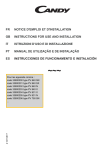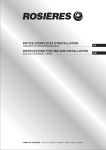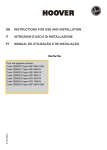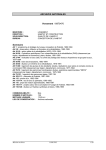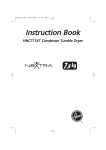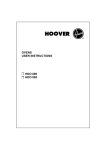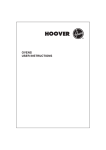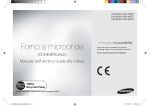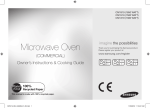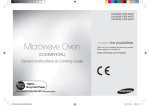Download ROSIERES Cookers Operating instructions
Transcript
The Rosières Bocuse cooker Operating instructions 44000571 BOCUSE RBC 127 AUS 1- Contents Section 1 An introduction to your Rosières Bocuse cooker • key features at a glance Section 2 Some words of caution Section 3 How to use your Rosières Bocuse cooker • gas burners • hob plate and griddle • the left oven • rotisserie • the right oven • oven accessories • cooking hints Section 4 Cleaning • cast-iron hot plate • stainless steel parts • enamelled cast-iron • gas burners • stainless steel parts • oven doors • the oven light • pyrolytic left oven • catalytic right oven -2 Section 5 Technical data and maintenance Section 6 Installation We recommend that your cooker is installed by professional fitters • connection to gas supply This must be carried out by a qualified gas fitter • setting hob jets • adjusting gas flame • with option splash-back : installation conditions Section 7 Electrical connection This must be carried out by a qualified electrician The cooker must be earthed Welcome …to the Rosières world of ‘cuisine complet’ The purpose of this user-guide is to introduce you to the many features and benefits of your Rosières Bocuse cooker – and to welcome you to our world of ‘cuisine complet’. As someone who loves to cook, you now have before you, at your fingertips, a cooker with the level of specification and performance which satisfies the requirements of the most demanding professionals. Originally designed for the internationally renowned chef Paul Bocuse, it has been adapted for the domestic market. Rosières have been manufacturing appliances which have won their place at the heart of French cuisine since 1869 and the Rosières Bocuse may be described as the only complete cooker. It combines craftsmanship and innovation, putting the technology of today at the service of the finest traditions of the chef’s art. So much more is put into the Rosières Bocuse – so you can get so much more out of it. Let your creative cooking have free rein and enjoy experiencing the world of cuisine complet with your Rosières Bocuse. Bon appetit! 3- COOKER : RBC 127 -4 TOP LEFT Ultra-rapid 4 kW safety gas burner, with electronic ignition The hot plate can be replaced with the meat griddle TOP RIGHT 4 safety gas burners with electronic ignition front left, ultra-rapid 3.5 kW back left, semi-rapid 1.40 kW front right, semi-rapid 1.40 kW back right, rapid Mijorose simmer safe burner 2.20 kW LEFT OVEN Electric Multi-function, 7 cooking functions Pyrolytic cleaning Equipped with clock programmer for controlling the cooking and pyrolytic functions Thermostat control indicator light and pyrolytic cycle indicator RIGHT OVEN Electric Conventional cooking with 4 cooking functions Oven, either catalytic or superenamel Equipped with end of cooking timer Thermostat control indicator light Section 1 An introduction to your Rosières Bocuse cooker Eager though you will be to start using your new Rosières Bocuse cooker, we advise that you take time to get acquainted: after all, this is going to be a long and creative relationship. Using the key features illustration as your guide, familiarise yourself with each part and function of the cooker which you will come to find offers you easy access, flexibility, safety, economy, efficiency, with precise control of timing and temperature. As you will see from this initial inspection, the Rosières Bocuse gives you: • Two full-sized electric ovens: Pyrolytic multi-function oven with diagonal rotisserie left oven - catalytic conventional oven (right oven) • Analogue clock programmer for multifunction oven • End of cooking timer for conventional oven • Flame failure device • 4 gas burners with cast iron pan supports including Mijorose simmersafe burner • 4 kW Super gas burner with cast-iron pan and Wok support • Cast-iron hotplate with griddle option • Height adjustment feature to a maximum 90 cm • Optional matching stainless steel splash-back • Two convenient storage drawers for kitchen utensils and cooker accessories As you begin using your Rosières Bocuse cooker you will find that its unrivalled array of features, together in this one appliance, puts you in total control – with all the advantages that brings. Whether it involves baking or blanching, simmering or grilling, no recipe will prove impossible. You will have your own favourites to try, of course. And to extend your range, you will find Paul Bocuse cookery books available at good bookshops. 5- Section 2 Some words of caution We want you to get maximum pleasure and benefit from your Rosières Bocuse cooker. But before we guide you through its many features, permit us to offer. a few important words of caution for your well-being and that of your cooker. We recommend that your cooker is: • professionally installed • it must be connected to the fuel supply by a qualified electrician and gas fitter • earthed - For safety reasons under no circumstances should any modifications be carried out to this appliance. - All the accessible parts are hot when the cooker is in operation. Keep young children away from the cooker when in use. - Both the ovens are fitted with a multi-layered glass door to prevent the possible risk of burns during operation (cooking modes). Nevertheless, we recommend you keep young children well away from the ovens especially during the left oven’s pyrolytic cleaning phase. - Prior to pyrolytic cleaning, wipe off any large food spillages. Indeed, excessive amounts of grease may catch fire under the intense pyrolytic heat. - Never use a steam or high-pressure spray to clean the ovens. - If your oven shows even the smallest defect, do not connect it. Disconnect it from the power supply and immediately contact an approved ROSIERES service agent. - Do not store flammable products in the cooker as they can catch fire if the cooker is inadvertantly switched on. - Do not lean on the oven doors or allow children to do so. - Use oven gloves, when placing or removing a dish from the oven. - After each use we recommend that some cleaning of the cooker, is undertaken. This prevents the accumulation of dirt and grease which gets re-cooked and burns, generating unpleasant smells and smoke. - Do not line the oven walls with aluminium foil or single-use oven protectors available from some stores. Aluminium foil or any other protection, in direct contact with the hot enamel, risks melting the enamel or causing deterioration to the inside. - When cooking with fats or oils, always take care to watch the cooking process as heated fats and oils can catch fire rapidly. -6 Cast-iron hot plate: essential pre-treatment before first use Caution: before using the hot plate for the first time, the following steps must be taken: • wash the plate with soapy water • sprinkle salt over the plate and then buff in the salt with black and white printed newspaper (not coloured) • heat the salted plate, allow to cool, wipe off the salt • using kitchen roll, wipe a thin layer of vegetable cooking oil over the top of the hot plate • turn on the burner to heat the hot plate for a few minutes • this will produce some smoke, so switch on the extractor hood • once the oil has disappeared, turn off the burner and let the hot plate cool • give the plate a light wipe with vegetable oil • leave to cool, the hot plate centre will turn light grey and the edges will remain dark grey • the hot plate is ready for use Caution: Please read this guide thoroughly before first using your cooker. Section 2 7- Section 3 How to use your Rosières Bocuse cooker We now come to the detailed practical guide to your cooker. We describe each feature, its function, and how it can benefit you in your cooking. RECOMMENDATIONS... - Do not use pans with a concave or convex bases. You can use a “Wok” as long as you install the Wok support griddle supplied with the cooker. - Avoid boiling food too quickly. A “high boil” doesn’t cook food any quicker, and as the food is violently agitated this can cause it to loose its taste. - Flames should not lick out from the pan base, this just means you are wasting gas. Only the base of the pan should be heated. Do not allow flames to project beyond this point. This means gas is being wasted. - Do not place an empty pan on a lit gas burner. Caution: when the burners are not in use, the main supply control should be closed. 1 2 4 5 3 1-5 • SEMI-RAPID BURNER: use the smallest burner for small pans. 2 • RAPID BURNER: use this burner for stewing and sauces. With medium rate, the flame is only in contact with the burner cap. Ideal for stewing, the heat is distributed evenly under the pan. Food does not stick and there is no crown effect in the bottom of the pan. 3 • MULTI PURPOSE HOT PLATE/SUPER BURNER: this burner provides various uses. A handling tool supplied with the cooker lets you remove the hot plate for adapting various components. 4 • ULTRA-RAPID BURNER: use this burner for bringing to the boil, sealing meat, and generally for all foods that need to be cooked quickly. For optimum burner utilisation, we recommend you use pans with diameters not less than those detailed below: Ultra-rapid Semi-rapid -8 ø 18 cm ø 12 cm Rapid Open hob ø 18 cm ø 24 cm USE Each burner has electronic ignition and a thermocouple safety device that automatically stops the gas if the flame goes out accidentally. • Open the gas tap. • A symbol near each knob lets you see which burner is in use. • Press in and turn the gas tap to the mark. Holding the knob in creates the ignition spark. Continue pressing the knob in for two seconds to set the safety device. • Adjust the flame according to your cooking needs. High Low • To stop the burner, set the knob to position"•". Note: If there is no electricity, the burner can be lit with a match. If the flame goes out accidentally, reignite the burner. MULTI PURPOSE BURNER Caution: the cast iron hot plate and the griddle cook at high temperatures. Please take extreme care and always keep children away. It is advisable to allow the cast iron parts to cool before moving them. Always use the lifting tool ensuring that the top of the tool is over the hot plate centre. HOT PLATE: ideal for simultaneous cooking, for sauces, lengthy stewing, or keeping foods warm. According to the dish, you can adjust the setting either by the control knob or by moving the pan over the cast iron plate. The temperature at the plate centre reaches 400°C, towards the outer edge the temperature decreases to 100°C for traditional slow simmering. GRIDDLE: for a brisk heat, etc. WOK SUPPORT: for WOK, use or when using a convex bottomed pan. It can be fitted to various burners. Section 3 OPEN HOB: accommodates large quantities of food and large pans. Remember to position the spacer and its core for optimal operation. 9- COOKING METHODS : All cooking should be carried out with the door closed. Defrost: The cooking fan runs circulating air inside the oven. Ideal for defrosting before cooking. Conventional cooking: Top and bottom heating elements are used together. Preheat the oven for about ten minutes. This method is ideal for all traditional roasting and baking. For sealing red meats, roast beef, leg of lamb, game, bread, foil-wrapped food (papillotes), flaky pastry. Mid shelf position recommended. Fan cooking: Both top and bottom heating elements are used and the fan circulates the air inside the oven. Recommended for poultry, pastries, fish and vegetables. Heat penetrates the food better and both the cooking and preheating times are reduced. Different foods can be cooked at the same time in one or more positions. This function provides even heat distribution and does not mix the smells. Allow about ten minutes extra when cooking foods at the same time. Lower element: Using the lower element. Ideal for cooking all pastry based dishes. This allows you to cook dry tart pastry without over cooking the fruit filling. Use this for flans, quiches, tarts, pâté and any cooking that needs more heat and radiation from below. Fan & Lower element: The bottom heating element is used in conjunction with the fan which circulates the air inside the oven. This method is ideal for moist fruit flans, tarts and pâté. It prevents food from drying out and encourages rising cakes, bread dough and other foods. Bottom cooking. Put the shelf at a lower shelf level recommended. Grill: Using the top level element. Success is guaranteed for mixed grills, kebabs and au gratin dishes. Five minutes preheating is required to get the element hot. Use the grill when the door is closed. The right oven has two grill positions: grill = 2140 W, grill with extra = 3000 W. Fan assisted grilling: The top heating element is used in conjunction with the fan circulating the air inside the oven. Ideal for cooking thicker food stuffs, whole pieces of meat such as roast pork, poultry, etc. Preheating is necessary for red meats but not for white meats. Place the food to be grilled directly on the shelf centrally, at the middle level. Slide the drip tray under the shelf to collect the juices. Make sure that the food is not too close to the grill. Turn the food over halfway through cooking. Rotisserie: The top heating element is used in conjunction with the rotisserie providing the real flavour of a traditional roast. -10 LEFT OVEN Clock programmer Pyrolytic cleaning indicator Thermostat control indicator Function selector Thermostat knob SETTING THE PROGRAMMER The clock must be set before using the oven for the first time. To set the time, press in and turn the button clockwise. Move the clock’s hour and minute hands to the correct time. USING THE LEFT OVEN > Turn the function selector to the cooking position you want. > Set the thermostat knob to the required temperature based on the information below. Defrost Thermostat knob to stop position Conventional cooking from 60°C to 280°C Fan cooking from 60°C to 230°C Fan + Lower element from 60°C to 230°C Grill from 220°C to 275°C Turbo grill from 180°C to 230°C Rotisserie from 220°C to 275°C > In order to operate the oven either set to manual ( symbol in window) or automatic (cooking duration time displayed in window). Before programming, the “C” pointer must be positioned under the hour hand, if not: pull out and turn the button clockwise. Pointer “C” Hand position Immediate programming with a cooking duration Section 3 In the hand position, or with a cooking duration displayed, the oven starts immediately, to set Manual symbol or time in window turn the button clockwise without pulling it and release it. 11- In hand position, the oven must be stopped manually by returning the function selector and thermostat knobs to the stop position. For programming with immediate start and cooking duration, the oven stops automatically once the time has elapsed and an audible alarm sounds. To stop the alarm, turn the button to display in the little window. Return the function selector and thermostat knobs to the stop position. > The cooking start time can be delayed... To set the start time: pull out and turn the button to the right to put the ‘C’ pointer to the required starting time, and release it. To set the cooking duration: turn the button clockwise, without pulling, to display the time required to cook the food. The oven starts at the programmed time and stops operating automatically once the time has elapsed. The end of cooking time is signalled by an alarm that rings for several minutes. To stop the alarm, turn the button to display and return the function selector and thermostat knobs to the stop position. ROTISSERIE This consists of one skewer, two forks and a spit holder. . Take all the accessories out of the oven. . Place the deep tray at the bottom. . Put the food onto the skewer, and centre between the two forks. . Put the skewer onto the holder. . Slide the holder and skewer into the second shelf position from the bottom. . The end of the turnspit should be opposite the opening of the drive device. . Engage the turnspit in the drive device. Fitting the turnspit diagonally: -12 Œ • Ž • Drive device No preheating is required for Rotisserie cooking. Rotisserie cooking is carried out with the door closed. RIGHT OVEN End of cooking timer with hand position Thermostat control indicator Function selector Thermostat knob USING THE RIGHT OVEN > Turn the function selector knob to the cooking position you require. > Set the thermostat knob to the required temperature based on the information below. Conventional cooking from 60°C to 280°C Lower element from 60°C to 230°C Grill from 220°C to 275°C > Set the timer knob to the hand position or to a duration. Note: to indicate a duration on the timer, turn the knob clockwise up to 120 minutes then return it to the required duration. Hand position Duration : 1-120 minutes Whatever programming method is selected, the oven starts immediately. In hand position, the oven must be stopped manually by returning the function selector and thermostat knobs to the stop position. When programming a duration, the oven stops automatically once the time has elapsed. The regulation indicator shows the use and operation of the thermostat. It comes on and goes off regularly throughout the cooking duration time. The pyrolytic cleaning indicator comes on as soon as the control knob is on the P position and goes off when the oven temperature rises to 300°C. Section 3 INDICATORS 13- COOKING HINTS Temperatures and cooking times are given as guidance for oven use. Personal experience should then let you adapt these settings to your own taste. Remember that cooking at higher temperatures causes more spattering, and the oven becomes dirty causing smoke. It is better to slightly reduce the cooking temperature, even if it means increasing the cooking time. 4 3 2 1 Oven walls are equipped with different shelf positions numbered from the bottom. SHELF POSITION FISH Recipe -14 Cooking Quantity Method Cooking °C Cooking time Shelf position from bottom of the oven Trout or Bream Conventional cooking 1 kg whole 220°C 30 min 1 Monk fish or Salmon Conventional cooking 1 kg poached 220°C 30 min 1 Salmon steak Fan cooking 6 pieces 140-160°C 10-15 min 1 Fillet of sole Fan cooking 6 pieces 160°C 15-20 min 1 Grilled fish Grill 6 fillets 275°C 2 X 5 min 4 MEAT It is better not to salt meat until after cooking as salt encourages the meat to spatter fat. This will dirty the oven and generate a lot of smoke. Joints of white meat, pork, veal, lamb and fish can be put into a cold oven. The cooking time is longer than for a preheated oven, but it cooks through to the middle of the food as the heat has more time to penetrate. Correct preheating is the basis of successful red meat cookery. FOR GRILLING Preparing for a mixed grill: Remove the meat from the refrigerator a few hours before grilling. Lay it on several layers of kitchen roll: this improves sealing, making it tastier and ensures that it cooks right through to the centre. Add pepper and spices to the meat before grilling, but add any salt after cooking. This way it will seal and stay moist. Baste all the food to be cooked with a little oil. This is best done with a wide flat basting brush. Then sprinkle with more pepper and herbs. Put the grill dish into the oven. During cooking: Never pierce the food during cooking, or when you turn it over: juice runs out and the meat becomes dry. Section 3 15- MEAT Recipe Cooking Method Quantity Cooking °C Cooking time Beef with carrots Conventional cooking for 6 200-220°C about 4 hr Duck Conv. cooking 1.5 kg 200-220°C 1½ hr Turkey Conv. cooking 5-6 kg 160-180°C 2½-3 hr Goose Conv. cooking 3-4 kg 160-180°C 2-2½ hr Leg of lamb Conv. cooking 200-220°C 15 min/pound Roast chicken Conv. cooking 220°C about 1 hr Roast beef Conv. cooking 240°C 15 min/pound Roast rabbit Fan cooking 800 g – 1 kg 200-220°C Roast white meat Fan cooking 200-220°C 40-50 min/kg Boeuf bourguignon Lower element* for 6 200°C 1½ hr Cast-iron casserole with lid Chicken casserole Lower element* 1.5 kg 210°C 1½ hr Cast-iron casserole with lid Veal/poultry Rotisserie 1.2 kg 275°C 60-70 min/kg No preheat required Veal/poultry Rotisserie 1 kg 275°C 45-50 min No preheat required Beef Rotisserie 1 kg 275°C 15-20 min No preheat required Lamb/Mutton Rotisserie 1 kg 275°C 20-25 min No preheat required Pork Rotisserie 1 kg 275°C 45-50 min No preheat required Kebabs Grill 6 pieces 275°C 2 x 8 min Turn over half way through cooking Pork chop Grill 6 pieces 275°C 2 x 8 min Turn over half way through cooking 1-1.5 kg Hints 50-60 min * for the fan and lower element cooking method, we recommend preheating with fan cooking. All cooking was done at shelf position “1”. -16 VEGETABLES – OTHERS Recipe Braised cabbage Cooking Method Quantity Cooking °C Cooking time Conv. cooking for 6 200-220°C 1 hour 200-220°C 1 hour/kg Pâté en croûte Conv. cooking Hints Chicory with gruyere Fan cooking for 6 180-200°C 25-30 min Jacket potatoes Fan cooking for 6 200-220°C about 1 hour Soufflé, savoury /sweet Fan cooking for 6 180-200°C 50-60 min Stuffed tomatoes Fan cooking 6-8 pieces 200-220°C 40-45 min Pilau rice Lower element 300 g 200°C 25 min Leek flan Fan + Lower element for 6 220°C 35-40 min Quiche Lorraine Fan for 6 + Lower element 220°C 45-50 min Toast with cheese* Turbo grill 6 pieces 210°C 3 min to toast one side + 4 min/cheese Dauphiné (cheese-topped Turbo grill dish)* 6 portions 200°C 45 min Oval dish Sausages* 4 pieces 210°C 2 X 10 min Turn over Half way through cooking Flat pan Turbo grill mould Ø 22 Flat pan All the cooking was done at shelf position “1” except cooking marked “*”, which requires cooking at a middle shelf position. 17- BAKING Avoid using shiny tins as they reflect heat and can spoil your cakes. If your cakes brown too quickly, cover them with grease-proof paper or aluminium foil. Caution: the correct way to use foil is with the shiny side in towards the cake. If not the heat is reflected by the shiny surface and does not penetrate the food. Avoid opening the door during the first 20 to 25 minutes of cooking: soufflés, brioche, sponge cakes will tend to fall. You can check if cakes are done by pricking the centre with a knife blade or skewer. If the blade comes out nice and dry, your cake is ready and you can stop cooking. If the blade comes out moist or with bits of cake attached, continue baking but slightly lower the thermostat so that it is finished off without burning. Recipe Cooking Quantity Method Cooking °C Cooking time Shelf level Cake Conv. cooking 1.5 kg 180-200°C 50-60 min 1 Fruit tart in batter Conv. Cooking for 6 200-220°C 40-50 min 1 Pound cake Conv. cooking 1.5 kg 200-220°C 45-50 min 1 Filled pie Conv. cooking for 6 200-220°C 40-45 min 1 Brioche Fan cooking 800 g 200°C 40-45 min 1 Sponge cake Fan cooking 180-200°C 35-40 min 1 Genoese cake Fan cooking 180-200°C 30-35 min Hints Ø 27 Ø 27 Ø 27 Ø 27 Choux pastry Fan cooking 40 pieces 190°C 35 min 1 and 3 2 trays Pastry base Fan cooking for 6 180-200°C 20-30 min 1 Ø 27 Puff pastry e.g. bouchée Fan cooking 6 pieces 200°C 15-20 min 1 Meringues Fan 1 tray + Lower element* 80-85°C 4½ hours 1 Fruit tart Fan for 6 + Lower element* 220°C 35-40 min 1 * with fan and lower element cooking method, we recommend at first a preheating with fan cooking to save time. -18 COOKER EQUIPMENT THE MULTI PURPOSE HOT PLATE/SUPER BURNER AND ACCESSORIES Hot plate Hook Griddle Wok support . 1 Hot plate for cooking food using large pans, for stews, sauces, etc. . 1 Hook for removing the hot plate. . 1 Griddle for brisk grilling. . 1 Burner spacer with cast iron pan support for use when the burner is uncovered. . 1 Wok support grill. . 1 cast-iron pan support for open burner cooking. OVENS Flat shelf Pastry tray Tray holder shelf Drip-tray . 2 Flat shelves for supporting various dishes and moulds. . 3 Pastry trays with 1 stainless steel tray that slide directly into the oven shelf positions. They are for cooking small pastries, like choux, biscuits, meringues, etc. . 2 Tray holder shelves for supporting dishes or moulds. They can be combined with drip-trays on slides. . 2 Drip-trays to collect meat and grilling juices during roasting or grilling. They can be put on the shelves, or slid under them. Unless used with the grill, the drip-tray must not be stored in the oven while in use. All unused accessories must be removed from the oven when it is in use. Section 3 . 1 Flat shelf can be combined with the drip-tray for all types of grilling. A handle is supplied for removing grill pan from the oven without the risk of burning yourself. Never leave the handle inside the oven. 19- Section 4 Cleaning Cleaning your Rosières Bocuse cooker This section explains how to keep each part of your cooker clean and in peak operating condition. Before carrying out any cleaning, you must: . disconnect the appliance from the electrical supply. . wait for all the hot parts to cool. Never use abrasive cleaners, wire wool or sharp objects to clean the top. TOP LEFT - Polished cast-iron plate: protective finish is applied to the cast-iron plate when it leaves the factory. The finish can easily be removed using a strong liquid detergent (ammonia based). To clean it, rub the plate with fine emery paper to clear any rust spots. Wipe with a slightly oily cloth to prevent rust forming. When in use, daily cleaning is required to keep the top of the cast-iron plate looking good. General stores stock various products for cleaning the polished top. For additional protection, we recommend you clean the cast-iron top regularly with a slightly oily cloth. - Enamelled cast-iron frame: when the cooker is cold, just clean using a nonabrasive liquid detergent, rinse and wipe off with a clean dry cloth. Cleaning hot enamel risks tarnishing it. TOP RIGHT - Burner caps and pan supports in enamelled cast-iron: clean as described above for the enamelled cast-iron frame. - Gas burners: for normal cleaning, it is recommended to clean off all grease or burnt-on deposits using ammonia or commercial, non-abrasive cleaners. Do not put the burner caps straight into cold water after use in order to prevent heat shock from rupturing the enamel. To conserve the original appearance of the burner bodies, use a non-abrasive detergent, rinse and dry carefully. If the holes are clogged, brush them with soapy water, rinse and dry. When refitting these parts, make sure that each of them is wiped dry. Check that each part is correctly positioned before using the cooker hob again. - Caution: do not let water get inside the gas burners. STAINLESS STEEL PARTS – clean with soft cloth and a special stainless steel cleaner available from most department stores. ENAMEL CAST-IRON PARTS - when the cooker is cold, clean using a nonabrasive liquid detergent, rinse and wipe off with a clean dry cloth. -20 OVENS . Whatever the cleaning method, do not let fatty residues accumulate inside the oven. Clean it regularly. . Never line the oven sides with aluminium foil or single-use commercial protection; this concentrates the heat causing the enamel to deteriorate. - Oven doors: the door can be cleaned in situe or can be removed. . Remove as follows: . fully open the door; the hinge appears as in photo 1; . lift the hinge pins (photo 2) and pull the door upwards partially closing it until released. For installation, make sure you reposition the hinges carefully; a notch located below them (photo 3) lets you fit the hinges correctly. After the door is put back on its supports, fit the hinge pins in their initial position as in photo 4. 1: initial position with pin to bottom 2: lift the pin 3: hinge notch <------------ Removal --------------------> <----------------- Installation --------------> - Oven door glass: after each use of the oven, wipe using absorbent kitchen roll. If there is a lot of spattering, clean the glass with a sponge and detergent. Rinse and dry. - Oven lighting: Disconnect all power supplies from the oven before cleaning or replacing the bulb. The bulb and its cover are made of material resistant to high temperatures. Section 4 Bulb characteristics: 230 V AC - 25 W – Base E 14 - Temperature 300°C. To change a defective bulb, just: . unscrew and remove the glass cover, . unscrew the bulb; . replace it with the same type: see characteristics above; . after replacing the defective bulb, screw back the protective glass cover. 21- LEFT PYROLYTIC OVEN Pyrolytic cleaning uses high temperatures to destroy soiling. The resulting smoke is cleaned by passing through a catalyst. Because of the high temperatures involved, the oven door has a safety lock that prevents it being opened during pyrolytic cleaning. When the pyrolytic cycle is running, you may notice a slight odours; its intensity will depend on the amount of ventilation in the room. IMPORTANT: . It is important to clean off accumulated grease. Indeed, any grease deposits may catch fire under the intense heat involved in pyrolytic cleaning. . You are strongly advised not to use detergents or any other proprietary product for cleaning ovens. . Do not use the left-hand gas plate during pyrolytic cleaning. • Before commencing pyrolytic cleaning: . Remove all the accessories from the oven; they are likely to be damaged by the heat generated during the pyrolytic cleaning process. . Remove large spills of food or waste that would take too long to be carbonized. . Close the door. • Starting pyrolytic cleaning: Turn the function selector to the P position. Leave the thermostat knob on the ‘stop’ position. • Display a cleaning duration on the programmer: Before programming, check on the programmer that the pointer ‘C’ should be positioned under the hour hand, if not: pull out and turn the button clockwise. To set the cleaning duration, turn the button clockwise and then release it. Pointer “C” Immediate start and pyrolytic cleaning time Minor soiling: 90 min., medium soiling: 105 min., very soiled: 120 min. With immediate start and duration programming, the oven stops automatically once the time has elapsed and an audible alarm sounds to warn you. To stop the alarm, turn the button to display in the little window. Turn the function selector knob to the stop position. -22 • The pyrolytic cleaning cycle can be delayed... Setting a programming start time: pull out and turn the button clockwise to put the ‘C’ pointer to the starting time, and release it. Displaying a duration: turn the button clockwise, without pulling it, to display the time required for the pyrolytic cleaning cycle. The oven starts at the programmed time and stops operating automatically once the time has elapsed. The end of the time is signalled by a bell that rings for several minutes. To stop the alarm, turn the button to display . Return the function selector knob to the stop position. Pyroysis leaves a white residue on the oven walls. Wait for the oven to cool completely then clean the inside of the oven with a damp sponge to wipe off the residue. RIGHT CATALYTIC OVEN OVEN WITH CATALYTIC WALLS – catalytic cleaning takes place while the oven is in use. The oven walls are coated with a special enamel, micropores encourage the combustion of grease. Each drop is eliminated by the combined action of the catalytic enamel and heat. • Regular cleaning: the accumulation of fine residual dust resulting from the combustion of grease may eventually reduce the enamel’s efficiency. To keep this enamel in peak condition, you should rinse the walls with very hot water after every 10-15 roasts. This quick job is made all the easier as the side walls can be fully removed to be washed in the sink. They are fixed by a central screw (unscrewed by hand) on the top of the wall, and held by two tabs at the bottom; release them by lifting. After rinsing and installing the sides in the cooker, dry the enamel by operating the oven at maximum position for ¼ hour. Note: if after normal use, you notice slightly darker marks on the oven walls don’t worry, this effect is quite normal, they are just grease marks in the process of being eliminated. ENAMEL OVEN – The oven has an enamelled surface when the catalytic side walls are removed. Clean inside the oven with a sponge soaked in washing up liquid and very hot water to remove hard grease marks. For heavy spattering use commercially available oven cleaners. Section 4 • If spills are large, the enamel should be cleaned to let it recover its efficiency. Follow these steps: . Wipe any big spills or deposits with a sponge soaked in very hot water, using ammonia liquid detergent. . Use a nylon brush on any marks that cannot be wiped away. . Then heat the oven for an hour set at the maximum thermostat position. . It may be necessary to repeat these operations several times, if the spillages are heavy. 23- Section 5 Technical data and maintenance This section details the dimensions of the appliance, the hob power rating, and the dimensions, power rating and power consumption of the two ovens. RBC 127 AUS Cooker dimensions HOBS Width 116,5 cm X Depth 61,5 cm 98 cm with back plate TOP LEFT front right TOP RIGHT semi-rapid 1,4 kW front left ultra-rapid 3,5 kW back right rapid simmer 2,2 kW back left semi-rapid 1,4 kW Hot plate / super burner burner 4 kW OVENS LEFT OVEN RIGHT OVEN 48 litres 50 litres 43 X 37,5 X 30 cm 42,5 X 39,5 X 30 cm Oven volume Width X Depth X Height Oven power under 230 V Multi-funtion Conventional cooking 40 W - Conventional cooking 2420 W 2420 W Fan cooking 2450 W - - 1560 W Fan + Lower element 1590 W - Gril 2140 W 2140 W - 3000 W Fan assisted grill 2170 W - Defrost Lower element Gril with extra Rotisserie 2140 W - Pyrolytic cleaning 2410 W - Maximum power 2450 W 3000 W Oven consumption Rise to 200°C 0,50 kWh 0,45 kWh Holding for 1 h at 200°C 0,60 kWh 0,65 kWh 3 kWh - Pyrolytic cleaning (80 minutes) All data is given for information only. In order to improve the quality of its products, ROSIERES may modify its appliances with technological developments which adhere to the conditions set out in the Consumer Code. Appliance compliant with Directives 89/336/EEC, 73/23/EEC, 89/109/EEC & 90/396/EEC. -24 Section 6 Installation The installation of household appliances is a delicate operation that, «if not done correctly», can have serious consequences for consumer safety. Therefore, this work must be entrusted to a professional who can carry it out in compliance with the technical standards in force. Rosières will not accept any responsibility in case of technical failure of the product whether or not it causes damage to goods and/or persons if the installation has not been carried out by a qualified engineer/gas fitter. • Before installation, the technician should: . Check the compatibility between the cooker and the gas installation. The cooker is factory set for use with the gas type as stated on the packaging and repeated on the label affixed to the cooker. . If necessary change the gas To adapt the cooker fit suitable jets that provide the nominal flow rate and by adjusting the air rings according to the information given on pages 26 to 28. • For installation, the technician should: . Install the cooker leaving a space of 1.5 cm on each side. The cooker is Class 1; furniture adjacent to the unit must not be higher than the top of the cooker. The cooker has five adjustable feet for perfect levelling on the floor. . Do not remove the cooker spacers at the back. Do not block the air outlet between the back plate and the wall. These alterations can cause abnormal heating of the cooker. . Comply with the installation conditions stated on page 31 when fitting the splash-back, optional accessory. . Make the gas connection to the installation according to the gas supply, page 29 to 30 , by connecting the gas supply pipe without forgetting to fit the seal. . Connect the cooker electrically in compliance with the information given on page 32/33. ANY MODIFICATION MADE TO THE GAS SETTING SHOULD BE NOTED ON THE LABEL AFFIXED TO THE COOKER. Section 6 . If the gas type has been changed, adjust the minimum flow of each gas burner as described on page 30. 25- GAS INSTALLATION AUSTRALY G20 G31 Gas connector 10 mbar 27,5 mbar tapered ISO 7-1 ¤ X ¤ AUS ¤ = Original setting: G20-10 mbar X = Gas setting possible CHANGING THE GAS: the calorific capacity and pressure of the gas vary according to the type of gas. When changing the gas, you should successively: * change the jets, see table page 28 for jet selection, * correct the flame appearance by adjusting the air ring, see table page 28, * and set the minimum flow of the gas burner tap. CHANGING JETS Each jet is identified with a mark. Burner jets To access the jets of the top burners, remove the top grills, caps and heads of all the burners. Use the key supplied with the cooker to unscrew the jets. According to the information given in table page 28, install jets suitable for the burner type and gas type supplied. Screw them right down. For reinstallation, fit the heads, burner caps and grills. -26 TOP JET Example above: ultra-rapid burner (x 2 jets) Hot plate burner jet The cast-iron top has to be removed after taking off the hot plate using the hook (see page 19). The cast-iron plate is held: . At the back by two screws located under the back plate (unscrew them), and at the front by two pins located under the control panel. Open the oven door and unscrew them. To access the jet, loosen the air ring and push it backwards. Loosen the jet with a 7 mm spanner holding the jet holder with a 16 mm spanner. Fit the jet suited to the burner type and the gas supply. Do not forget to replace the air ring in its initial position. Air ring Jet located under the air ring. ADJUSTING THE AIR RING Adjusting the air ring of the top burners and the hob burner. This lets you obtain correct combustion and maximum burner efficiency. The table on page 28 gives the dimension “X” in mm; it may be necessary to adjust this setting in a range +/- 1 mm to improve the flame’s appearance and quality. 1 – Top burners: To access the burner air rings, remove the burner grills and caps. The air ring is located in the extension of the burner body, and fixed with a screw. Unscrew the air ring. Adjust the air ring according to the dimensions given in the table. Lock the fixing screw. Install the various parts again. Semi-rapid or rapid burner Cote «x» Ultra-rapid burner C o te «x» "X" Section 6 27- ADJUSTING THE AIR RING 2 - Hot plate burner: The air ring is located in the extension of the burner body. Adjust the air ring according to the dimension given in the table below. Lock the fixing screw. Air ring Dimension "X" To reinstall, replace the cast-iron top, fix it with the two pins at the front under the control panel, and replace the two screws holding it under the rear back plate. Hob burner Semirapid Rapid Ultrarapid Semirapid semi-rapid rapid semi-rapid ultra-rapid*** back left back right front right front left Hob Gas 1 G 20 mbar Jet 10 175 G 31 27,5 110 BA kW Je t 3 4 1,5 4 BA kW Je t BA kW Inj. BA kW Inj. B A kW 105 6 1,4 130 10 2,2 105 6 1,4 122 14 3,5 65 7 1,4 80 9 2,2 65 7 1,4 70 14 3,4 BA = Air ring in mm - kW = burner power *** The ultra-rapid burner needs two jets 1 Original setting: G 20-10 mbar -28 GAS CONNECTION This must be done in compliance with the regulations in force in the installation country. In all cases, on the gas feed pipe provide a stop cock, a regulator or regulator release device for propane gas. Only use valves, regulators, ends and flexible tubes, regulators with the official mark of the installation country. GAS CONNECTION ACCORDING TO INSTALLATION: Natural Rigid, Flexible hose with mechanical fittings (1) Butane Rigid, Flexible hose with mechanical fittings (1) Propane Rigid, Flexible hose with mechanical fittings (1) 1 – Provided the flexible hose can be inspected for its entire length – Flexible hoses with mechanical fittings must be arranged to be away from any flames, and not deteriorated by the combustion gases, hot cooker parts or by any spills of hot food. TWO CONNECTION OPTIONS: - RIGID PIPE CONNECTION Connect directly to the manifold fittings. - CONNECTION BY FLEXIBLE HOSE WITH MECHANICAL FITTINGS Screw the hose nuts directly onto the manifold fitting on the one hand and onto the stop cock of the piping on the other hand. Section 6 29- MINIMUM FLOW ADJUSTMENT If the gas type has been altered, the stability of the flame in the minimum flow must be checked and set by adjusting the bypass screw. To access the top burner bypass screw, remove the control panel knobs. a) natural gas . unscrew the bypass screw one turn . replace the knob, light the burner and set to low. . remove the knob, screw the bypass screw until a reduced flame is obtained, staying stable when going from high to low position. Replace the knob. b) butane-propane: the setting is done by screwing right in (without forcing) the bypass screw whose calibrated hole provides the minimum flow. To access the hob burner’s bypass screw, remove its knob. a) natural gas: screw the bypass screw right in then unscrew it by two turns, replace the knob and light the burner, set it to low (to the stop), remove the knob, and screw the bypass screw to obtain a low flame that stays stable when going from high to low position. Replace the knob. b) butane-propane: the setting is done by screwing screw whose calibrated hole provides the minimum flow. burner bypass screw -30 to the stop the bypass INSTALLATION CONDITIONS WITH SPLASH-BACK OPTION For the cooker to operate properly, make sure not to block the ventilation flow outlet, especially when the optional Splash-back is installed, when a minimum distance of 20 mm must be allowed (see diagram). Not complying with this condition can damage internal components by overheating, which may have serious consequences for consumer safety. Section 6 31- Section 7 Electrical connection The installation receiving the appliance must comply with the standards in force in the installation country. The ROSIERES company does not accept any responsibility if this provision is not complied with. Caution: • Before connecting, the technician must check the power supply voltage shown on the meter, the circuit breaker setting, the fuse rating and the earth continuity of the installation. • Connection to the network must be by earthed socket outlet, or by means of a multi-pole circuit-breaker having a distance between contacts of at least 3 mm. If the appliance has a socket outlet, it must be installed so that the socket outlet is accessible. • The green/yellow protection wire must be linked to the earth terminals, of the appliance on one side, and the installation on the other side. • We decline any responsibility for any incident or its possible consequences that may arise when an appliance is used that is not connected to the earth, or connected to an earth whose continuity is defective. • All work in relation to the power supply cable must be carried out by the after sales service or someone with similar qualifications. The cooker comes without power supply cable. It is equipped with a terminal board for selecting the type of electrical connection appropriate to the installation. Single phase 220-240 V AC Two phase 220-240 V2 AC Three phase 220-240 V3 AC Three phase 380-415 V3N AC CONNECTING TO THE COOKER TERMINALS: The terminal strip is located at the back of the cooker. To open the terminal strip cover: . find the two tabs located on the sides, . put the blade of a screwdriver in front of each tab, push in Œ and press •, . remove the cover. Terminal strip x 3 shunts Œ • To make the connection: . strip the end of each conductor and attach them to the terminals, respecting the marks and the placing of the shunts as shown in the connection table, . unscrew the cable clamp, . pass the lead through the cable clamp. -32 Example of single phase connection. 1 – Shunt installation 2 – Wire installation 3 - The cable goes through the cable clamp. L1 N T Caution: incorrect tightening can cause dangerous heating risks for the power supply cable. When the connection operation to the appliance terminals is finished, tighten the cable clamp and close the cover. SINGLE PHASE 220-240 V~ TWO PHASES 220-240 V2~ THREE PHASES 220-240 V3~ THREE PHASES 380-415 V3N~ 25 A 25 A 25 A 16 A cross-section 3 G 2,5 mm² 3 G 2,5 mm² 4 G 2,5 mm² 5 G 1,5 mm² Type H05VV-F or H05RR-F H05VV-F or H05RR-F H05VV-F or H05RR-F H05VV-F or H05RR-F Fuse CABLE Connection to terminal block 1 2 L1 3 3 4 L1 1 1 2 L1 L1 L2 2 3 1 2 L2 L3 3 N 5 4 4 4 N 5 Shunt: make a bridge using a shunt L1 : Phase Shunt 1-2 and Shunt 2-3 N : Neutral Shunt 4-5 T : Earth 5 T L1 : Phase Shunt 1-2 and Shunt 2-3 L2 : Phase Shunt 4-5 T : Earth L3 5 T L1 : Phase Shunt 1-2 L2 : Phase Shunt 3-4 L3 : Phase 5 T : Earth T L1 : Phase 1 L2 : Phase 2 L3 : Phase 3 N : Neutral Shunt 4-5 T : Earth Section 7 T L2 33- -34 35- USINES DE ROSIERES RCS Bourges B 324 479 302 30, rue Y. LACELLE - Rosières - 18400 LUNERY Tél. 02.48.55.78.00 - Fax : 02.48.68.01.75 -36




































